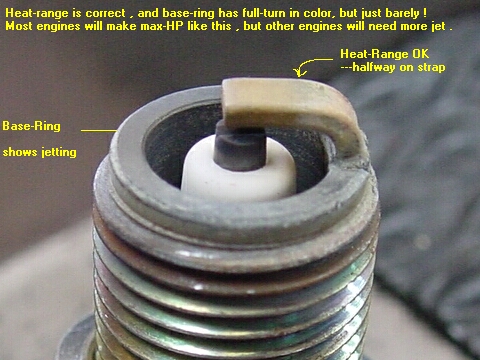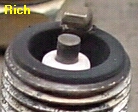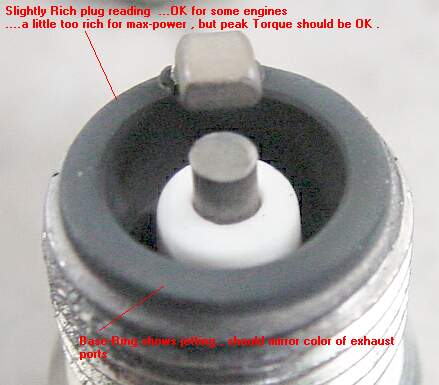|
|||||||
| Sponsored Links (Register now to hide all advertisements) |
|
|
 |

|
Thread Tools | Display Modes |
|
|
#1 |
|
Senior Member
Join Date: May 2010
Location: pittsfield, MA
Posts: 2,086
|
O K, I know I will get some flack but here is the evidence: I use Champion H-12's in our 59A-B (.032-.035). This plug has about 4000 miles on it and just returned from a 530 mile trip. Burned/leaked 3/4 qt of 20/50 Castrol on the trip. Compression is down to 70/80 lbs. Never any smoke and 47,000 mile engine has never been apart to my knowledge. Mostly high speed (55-60) driving on the last trip. Just pulled a couple of plugs and here is how they look. Engine always starts first turn hot or cold. The picture shows the porcelain sort of white but actually light straw.
 I think engine tuning, ignition and carb play the major role in plug condition so autolites and NGK's might appear the same. JMO John |
|
|

|
|
|
#2 |
|
Senior Member
Join Date: May 2010
Location: Michigan
Posts: 505
|
H-12's are two heat ranges hotter than H-10's. Your's look pretty good to me and are less apt to foul out than the H-10's. I'm not sure I get your point, or is it about all the bad press Champions have been getting?
|
|
|

|
| Sponsored Links (Register now to hide all advertisements) |
|
|
|
|
#3 |
|
Senior Member
Join Date: May 2010
Location: pittsfield, MA
Posts: 2,086
|
Maybe a little of defense for Champions, but more just showing some results. On our next long trip next month I am going to add one autolite and one NGK so we can compare the 3 after 500 miles. KenCT has suggested I go to .050 jets for a darker straw color, so they will be installed for the "test". Just having fun and re-inventing what the old time flathead guys probably knew. I will need some input on what Autolite and NGK would be in the heat range of the H-12's for a fair test. Any input? As mentioned, at 60 mph and 80's temp this engine burns/leaks 3/4 quart of Castrol 20/50 in 500 miles. (plus a pint of MMO in the tank and injected).
John |
|
|

|
|
|
#4 |
|
Senior Member
Join Date: May 2010
Location: Gardiner Me.
Posts: 4,200
|
I think your plugs are just right for your engine. 70-80# compression is a little low for what a lot of us are used to. My comp is 160#. I think H10's would be way to hot for my engine. I've got alot of mile on my 40 with a 276ci. My plugs have been in my engine for yr's, I cain't remember what I've got, I think there AC out of some truck. I did take 3-4 out last year after a 100 mile trip with 4 carbs (97"s) running straight linkage. they were almost white like your's. I got 18mpg on that trip on secondary roads and a couple of towns. I haven't been on a turnpike trip with the 4 cards. Of course I have a T-5 and 9in. rear with 3:50 gears. At 60mph with a GPS I'm turning 2000 RPM. Walt
|
|
|

|
|
|
#5 |
|
Senior Member
Join Date: May 2010
Location: NorCal
Posts: 2,617
|
John
I think you've got it about as good as it gets, especially when you consider the oil burning issue. Here's some info you and others may find useful. Note it's for racing, but may give you a good idea re plug reading. I also think Champion plugs are good. I've never had a problem. Jim Reading Spark Plugs by Meaux Racing Heads
Heat Range = Ground Strap, the ground strap indicates the heat-range of the spark plug. If the "color" of the ground strap "changes" too close to the ground strap's end, (which is above the center electrode), then the heat-range is "too cold", meaning that the strap is loosing heat too quickly to the base ring, and is not able to burn off deposits until near its end. If the "color" of the strap changes near where it is welded/attached to the base ring (last thread ring), then it means that the plug heat-range is "too hot", because heat is not being transferred/cooled from the strap to the base ring quickly enough !!!! The strap might begin to act like a "glow-plug", eventually causing preignition and/or detonation later on. Proper heat-range is when the "color" is at the halfway point on the strap, neither too cold or too hot. (Color = meaning the evidence of heat/or lack of heat by the appearance dark vs lightened color of metal)   Jetting Jetting Jetting = the air/fuel mixture ratio shows up on the base ring (the last thread ring, it has the strap welded to it). You want a full turn of light soot color on the base ring!!! If you want to tune for max. power, then you want 3/4 to 7/8ths of a full turn of light soot color to show up on the base ring, but this is on ragged-edge of being too lean, but will make the most HP on most engines. To be safe, leave it at a full turn of light soot color. If the base ring has a full turn of color, but there are "spots" of heavy buildup of "dry soot" on top of color, then jetting is too rich . 
 Preignition/Detonation Porcelain = the porcelain shows up preignition/detonation, it will not accurately reveal jetting/air/fuel ratios. To look for the first/beginning signs of detonation, search the white porcelain for tiny black specks or shiny specks of aluminum that have fused to the porcelain. When detonation occurs, part of the air/fuel mixture explodes instead of burning, the explosion is heard as a "metallic knock", this audible knock is the result of a sound shock-wave, this shock wave travels back and forth across the clearance volume "disrupting" the cooler boundary layer gases that cover the entire clearance volume area. This disruption allows "more" heat to be transferred into parts, especially, domes/piston tops,...along with the very rapid rise in pressure like a hammer blow, pistons can get torched with melted sides and holes !!! With the early signs of detonation, the shock-wave will also rattle rings causing the tiny amounts of oil that now gets by rings, to be fused to the white porcelain as tiny black specks, also fused as specks are soot that was clinging to clearance volume surfaces in the relatively "still-air" of the boundary layer. One step beyond the black specks, will be tiny specks/balls of aluminum coming off the pistons that will be fused to white porcelain,....the next step to be reached is occasional pieces of the porcelain being broken-off as detonation gets worse, ETC. Soon after that are holes, blown head gaskets, broken connecting rods, ETC.
Meaux Racing Heads 9827 LA Hwy. 343 Abbeville, Louisiana 70510 337-893-1541 |
|
|

|
|
|
#6 |
|
Senior Member
|
Sponsored Links (Register now to hide all advertisements)
the old H10 was discontinued years ago. the "C" means copper core. I have never used the H10C but have used the old H10 without problems. |
|
|

|
|
|
#7 |
|
Member Emeritus
Join Date: May 2010
Location: Fitzgerald, Georgia
Posts: 2,204
|
It is impossible to determine the viability of a plug heat range by viewing the colorations subsequent to an idle and low speed, period of operation. The results seen on the plug apply to the period just prior to the plugs being removed.
|
|
|

|
|
|
#8 |
|
Member
Join Date: Jun 2010
Posts: 65
|
might help
|
|
|

|
 |
«
Previous Thread
|
Next Thread
»
|
|
| Sponsored Links (Register now to hide all advertisements) |
|
|
All times are GMT -5. The time now is 05:54 AM.








 Linear Mode
Linear Mode

